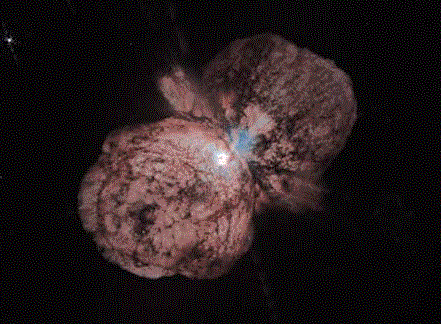Astronomy Picture of the Day
Discover the cosmos!
Each day a different image or photograph of our fascinating universe is
featured, along with a brief explanation written by a professional
astronomer.
June 11, 1996

Doomed Star Eta Carinae
Credit:
J. Morse
(University of Colorado),
K. Davidson
(University of Minnesota) and
collaborators,
WFPC2,
Hubble
Space Telescope,
NASA
Explanation:
Eta Carinae may be about to explode. But no one knows when - it may be
next year, it may be one million years from now.
Eta Carinae's mass - about
100 times greater than our Sun -
make it an excellent candidate for a full blown supernova. Historical records do show that about 150 years
ago Eta Carinae underwent an unusual outburst that made it one of the brightest stars in the southern sky.
Eta Carinae, in the
Keyhole Nebula, is
the only star currently
thought to emit natural LASER light. This
just-released
image taken last September resulted from sophisticated
image-processing procedures designed to bring out new details in the
unusual nebula that surrounds
this
rogue star. Now clearly visible are two
distinct lobes, a hot central
region, and strange radial streaks.
The lobes are filled with lanes of gas and dust which absorb the blue and
ultraviolet light emitted near the center. The streaks remain unexplained.
Will these clues tell us how the nebula was formed?
Will they better indicate when
Eta
Carinae will explode?
Tomorrow's picture: Vela Supernova Remnant in X-Ray
| Archive
| Index
| Search
| Glossary
| Education
| About APOD |




Authors & editors:
Robert Nemiroff
(GMU) &
Jerry
Bonnell (USRA).
NASA Technical Rep.:
Sherri
Calvo.
Specific rights apply.
A service of:
LHEA
at
NASA/
GSFC




